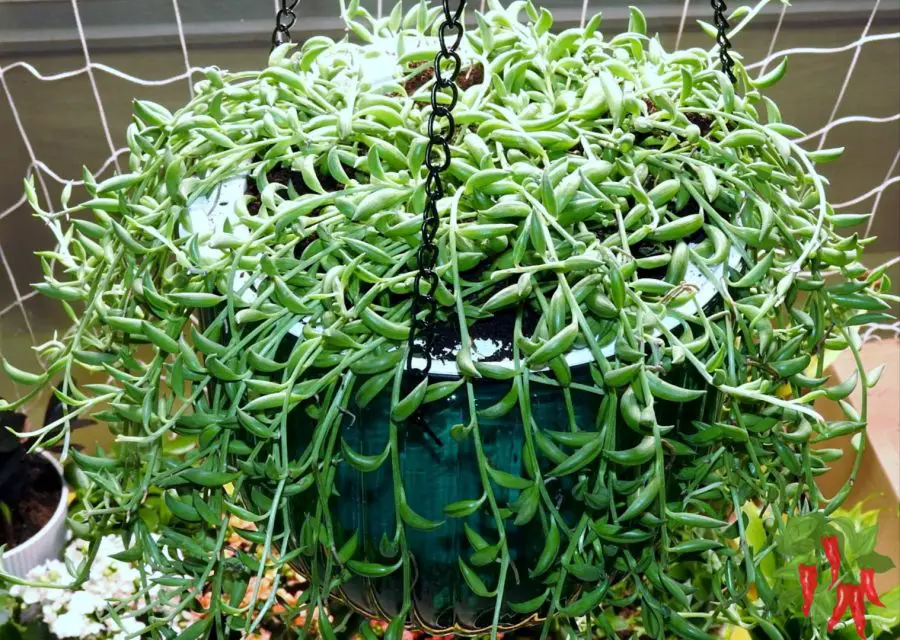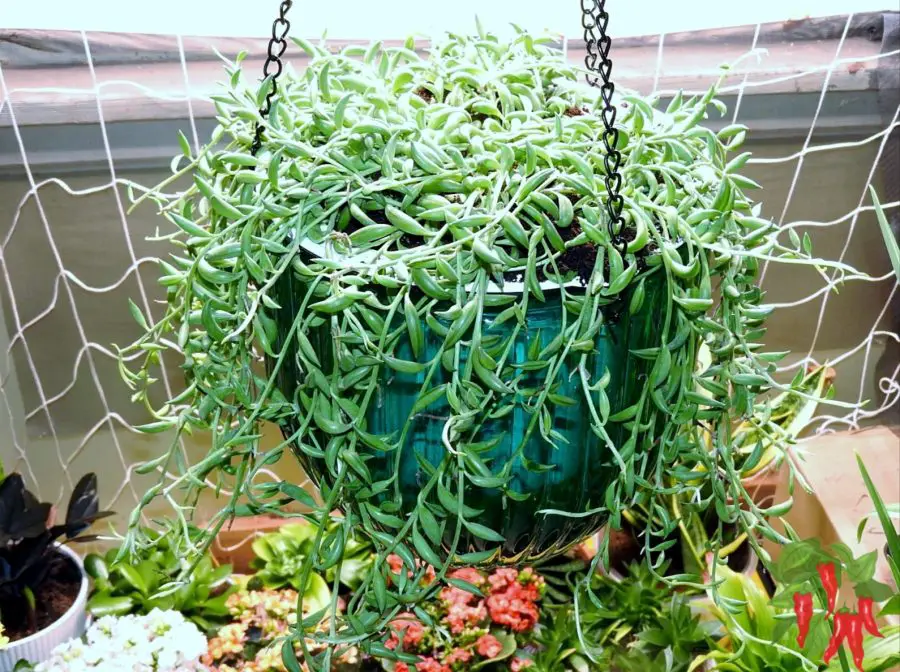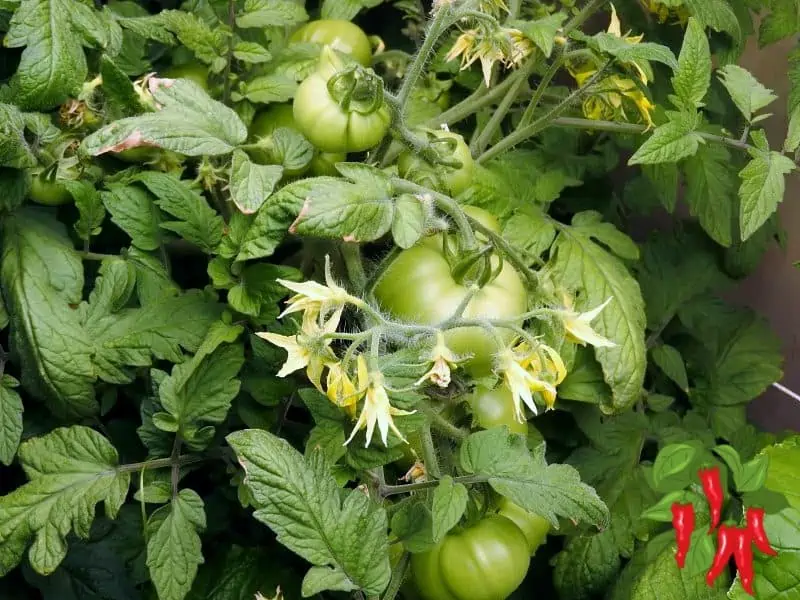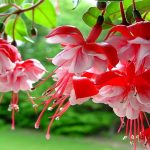This post may contain affiliate links. If you buy something from one of our links we may earn a commission. Thanks

String of Bananas an Easy Succulent Hanging Plant
String of Bananas is one of the easiest and most rewarding succulents you can grow indoors.
If you’ve struggled with delicate trailing plants before, you know how frustrating it can be to keep them happy.
The good news? This fast-growing succulent is hardy, low-maintenance, and perfect for brightening up any space.
Watch My String of Bananas Easy Care Guide for Beginners Video
String of Bananas Key Takeaways
- String of Bananas (Curio radicans) is a hardy, trailing succulent with banana-shaped leaves that stores water.
- It thrives in bright, indirect light and well-draining soil.
- Water only when the soil is dry to prevent root rot.
- Ideal for hanging baskets, it grows quickly and is easy to propagate from cuttings.
String of Bananas: Everything You Need to Know to Grow It
If you’re looking for a fun, low-maintenance plant that grows fast and adds a lush, trailing vibe to your space, String of Bananas might just be the perfect pick.
This unique succulent, also known as Curio radicans (formerly Senecio radicans), gets its name from its small, banana-shaped leaves that cascade beautifully from hanging baskets or shelves.
Unlike some trailing succulents that can be a little fussy, this one is easy to care for and grows quickly with just a little attention.
Whether you’re a beginner just starting out or an experienced plant lover looking for something new, String of Bananas is a fantastic addition to your indoor or outdoor plant collection.

String of Bananas Succulent, Hanging Plants Live Succulents, Hanging Planter Basket
How To Grow String of Bananas An Overview

Botanical Classification
String of Bananas (Curio radicans, formerly Senecio radicans) belongs to the Asteraceae family, the same group as daisies and sunflowers.
Though once classified under Senecio, it was reclassified as Curio due to its unique growth characteristics and succulent nature.
Native Habitat & Natural Growth
This fast-growing, trailing succulent originates from South Africa, where it thrives in dry, rocky landscapes.
In its natural habitat, it spreads across the ground, rooting along its stems to create dense, sprawling mats of greenery.
Ideal Growth Conditions
Unlike some succulents that grow slowly, String of Bananas grows rapidly when given the right conditions.
Its cascading vines are lined with small, banana-shaped leaves, which store water and allow it to survive with minimal watering.
It’s a great choice for hanging baskets, wall planters, or as a trailing plant on shelves.
Comparison to String of Pearls
Compared to String of Pearls (Curio rowleyanus), String of Bananas is much hardier and faster-growing.
While both plants have a similar trailing habit, String of Bananas is more forgiving with watering and light, making it a better option for beginners.
It’s also less prone to shriveling, meaning it stays lush and full with minimal effort.
If you’ve struggled with String of Pearls, this is a great alternative that provides a similar look with fewer maintenance challenges.
3. Light Requirements
Bright, Indirect Light is Best
String of Bananas thrives in bright, indirect light, making it perfect for sunny indoor spaces or shaded outdoor spots.
While it can handle some direct morning sun, too much intense sunlight—especially in the afternoon—can scorch its delicate leaves.
Indoor Light Needs
For the best growth indoors, place your plant near a south- or east-facing window where it can soak up plenty of indirect light.
If natural light is limited, a grow light can help maintain its vibrant green color and prevent stretching.
Outdoor Light Needs
Outdoors, this plant does well in partial sun, meaning it enjoys a few hours of gentle morning light but should be protected from harsh afternoon sun.
Too much direct sunlight can cause leaf burn, leading to brown, crispy patches.
Signs of Light Stress
If your String of Bananas isn’t getting enough light, you may notice etiolation (stretched, leggy growth) as it reaches for more light.
On the other hand, if it’s getting too much sun, the leaves may turn pale, yellow, or scorched. Adjust the placement to keep your plant happy and healthy.
4. Watering Needs
Drought-Tolerant Succulent
Like most succulents, String of Bananas stores water in its thick, banana-shaped leaves, making it naturally drought-tolerant.
This means it can go for long periods without water and is much more likely to suffer from overwatering than underwatering.
How Often to Water
For a healthy plant, water every 2–3 weeks, allowing the soil to completely dry out between waterings.
If you’re unsure, it’s always better to wait a few extra days rather than risk overwatering.
In cooler months, reduce watering to once a month since the plant enters a slower growth phase.
The Dangers of Overwatering
Overwatering is the most common issue, leading to root rot, mushy stems, and yellowing leaves.
If you notice a rotting smell, black stems, or soft leaves, cut back on watering immediately.
Signs of Underwatering
If your String of Bananas is underwatered, the leaves may become thin, wrinkled, or shriveled.
If this happens, give it a deep watering and adjust your schedule to prevent excessive dryness. With the right balance, your plant will stay lush and thriving.
5. Soil & Potting
Well-Draining Soil is Essential
String of Bananas thrives in a light, well-draining soil mix that prevents excess moisture from sitting around its roots. Since it’s highly prone to root rot, proper aeration is key.
Best Soil Blend
A great mix for this plant includes cactus soil with added perlite or sand to improve drainage.
My go-to blend is coco coir and perlite, which provides excellent airflow while retaining just the right amount of moisture.
Unlike traditional peat-based mixes, coco coir is more sustainable and resists compaction over time.
Choosing the Right Pot
To keep your plant healthy, use a terracotta or unglazed ceramic pot with drainage holes.
These materials help wick away excess moisture, reducing the risk of overwatering.
Be careful if using plastic pots, as they tend to hold more water, which can quickly lead to root issues.
6. Temperature & Humidity
Ideal Temperature Range
String of Bananas thrives in temperatures between 65-80°F (18-27°C), making it perfect for most indoor environments.
However, it is not cold-hardy and should be kept above 50°F (10°C) to prevent damage.
If you’re growing it outdoors, bring it inside when temperatures drop to avoid frost damage.
Humidity Preferences
Unlike some tropical houseplants, String of Bananas isn’t picky about humidity. It prefers dry to moderate conditions, similar to its native arid habitat.
Excess humidity can cause mushy stems and root rot, so avoid placing it in overly damp areas.
Where to Keep It
Bathrooms or other high-humidity spaces aren’t the best locations for this plant.
Instead, keep it in a well-ventilated area with plenty of airflow to ensure it stays happy and healthy.
If you live in a humid climate, make sure your plant is in a well-draining pot and soil mix to prevent moisture buildup.
7. Fertilizing Needs
Light Feeding for Healthy Growth
String of Bananas benefits from occasional feeding during its active growing season in spring and summer.
While it doesn’t need heavy fertilization, a little fertilizer boost helps encourage lush, vibrant growth.
Best Fertilizer & Application
Use a diluted succulent fertilizer at half strength once a month during the warmer months.
A balanced liquid fertilizer (such as 10-10-10 or 20-20-20) works well, but avoid high-nitrogen formulas, which can cause weak, leggy growth.
Avoid Over-Fertilizing
Too much fertilizer can make the vines stretch out and become thin or sparse.
During fall and winter, when growth slows, it’s best to skip fertilizing altogether to let your plant rest.
8. Propagation Methods
Stem Cuttings: The Easiest Way to Grow More Plants
If you love your String of Bananas and want more, propagation is super simple! The easiest method is stem cuttings
Just take a healthy strand, trim a section 4-6 inches long, and remove the lower leaves. You can either lay it on top of the soil or root it in water before planting.
Water vs. Soil Propagation
- Water Propagation: Place the cuttings in a jar with water, ensuring only the stem (not the leaves) is submerged. This method lets you watch the roots grow, but transitioning to soil later can sometimes cause shock.
- Soil Propagation: Lay the cuttings directly on top of dry succulent soil, gently pressing them in. After a few days, lightly mist the soil and keep it slightly damp until roots form. This method prevents transplant shock and is generally the best option.
Best Time to Propagate
For fast root development, propagate in spring or early summer, when the plant is actively growing. Warmer temperatures and longer daylight hours speed up root formation, giving your new plant the best start!
9. Common Problems & Solutions
Overwatering → Root Rot
The most common issue with String of Bananas is overwatering, which leads to root rot.
If your plant’s stems turn black or mushy, remove any affected parts and let the soil dry completely before watering again.
Make sure your plant is in a well-draining pot with proper soil (I prefer coco coir and perlite for extra airflow).
Leggy Growth → Not Enough Light
If your plant looks stretched out with long, sparse vines, it’s not getting enough light.
Move it closer to a south- or east-facing window or use a grow light to encourage compact, fuller growth.
Leaves Shriveling → Underwatering or Too Much Heat
Shriveled, wrinkled leaves mean your plant is too dry or too hot. Check if the soil is completely dry—if so, give it a deep watering.
If it’s near a heat source or in direct afternoon sun, move it to bright, indirect light.
Pests → Aphids & Mealybugs
Watch for tiny pests like aphids or mealybugs, which suck moisture from the leaves.
Treat infestations with neem oil, insecticidal soap, or a quick rinse under water to keep your plant pest-free.

String of Bananas Plant Care Reference Guide
| Characteristic | Details |
|---|---|
| Common Name | String of Bananas |
| Botanical Name | Curio radicans (formerly Senecio radicans) |
| Native Habitat | South Africa |
| Plant Type | Trailing succulent |
| Growth Pattern | Fast-growing, trailing vine |
| Mature Size | Up to 3 feet long |
| Watering | Every 2–3 weeks; allow soil to dry completely |
| Light/Sun Exposure | Bright, indirect light; can tolerate some morning sun |
| Soil Type | Well-draining mix; cactus soil with perlite or coco coir |
| Soil pH | 6.0-7.0 (slightly acidic to neutral) |
| Temperature | 65-80°F (18-27°C); keep above 50°F (10°C) |
| Humidity | Prefers dry to moderate humidity |
| Bloom Time & Flower Color | Spring; small, white to pale yellow flowers |
| Potential Problems | Root rot (from overwatering), leggy growth (low light), pests (aphids, mealybugs) |
| Repotting | Every 2-3 years or when rootbound |
| Hardiness Zones (USDA) | 10-12 |
String of Bananas: Easy Care Guide for Beginners FAQs
Caring for String of Bananas is simple, but you might have a few questions about keeping it healthy. Here are some common questions and expert answers to help you grow a thriving plant.
Q: How often should I water String of Bananas?
A: Water every 2–3 weeks, allowing the soil to dry out completely between waterings. Overwatering can cause root rot, so be sure the pot has drainage holes.
Q: Does String of Bananas need direct sunlight?
A: It thrives in bright, indirect light but can handle some direct morning sun. Too much direct sunlight may scorch the leaves, while too little light can cause leggy growth.
Q: Can I grow String of Bananas indoors?
A: Yes! It does well indoors as long as it gets plenty of bright, indirect light. A south- or east-facing window is ideal.
Q: How do I propagate String of Bananas?
A: Take a stem cutting, let it dry for a day, then place it in soil or water until roots form. Once rooted, transfer to a pot with well-draining soil.
Q: Why is my String of Bananas turning yellow?
A: Yellow leaves usually mean overwatering. Let the soil dry out before watering again, and check for proper drainage.
Q: Is String of Bananas toxic to pets?
A: Yes, it is considered mildly toxic to pets if ingested. Keep it out of reach of cats and dogs to prevent any issues.
Q: What’s the best soil for String of Bananas?
A: Use a well-draining succulent or cactus mix. Adding perlite or sand helps improve drainage and prevents root rot. I like to use a coco coir perlite mix for my plants.
Q: Why is my String of Bananas getting leggy?
A: If the plant is stretching with sparse leaves, it needs more light. Move it to a brighter location or supplement with a grow light.
Q: How fast does String of Bananas grow?
A: It’s a fast grower compared to other succulents. With proper care, it can grow several inches per month during the growing season.
Q: Can I fertilize my String of Bananas?
A: Yes, but sparingly. Use a diluted succulent fertilizer once a month during spring and summer. Avoid over-fertilizing, as it can cause weak, leggy growth.
String of Bananas Final Thoughts
Why You’ll Love String of Bananas
If you’re looking for a fast-growing, low-maintenance succulent, String of Bananas is an excellent choice.
Whether you hang it in a basket indoors or let it trail outdoors, this plant adds a beautiful, cascading effect to any space.
Key Care Recap
- Light: Bright, indirect light with some morning sun.
- Water: Every 2–3 weeks, letting the soil dry out completely.
- Soil: Well-draining mix with coco coir and perlite.
- Temperature: Keep above 50°F (10°C); avoid frost.
- Propagation: Easy with stem cuttings in spring or summer.
Start Growing Your Own!
With its unique banana-shaped leaves, rapid growth, and easy care, String of Bananas is a great plant for beginners and experienced gardeners alike. Give it the right balance of light, water, and soil, and you’ll have a lush, trailing succulent that’s sure to impress!

String of Bananas Succulent, Hanging Plants Live Succulents, Hanging Planter Basket
Read More:
Indoor Apartment Gardening: 15 Point Comprehensive Guide
Curio radicans/Senecio radicans
Curio radicans,syn. Senecio radicans, is a succulent plant native to Southern Africa. A member of the family Asteraceae, the asters, this species is closely related to the common string of pearls and Curio hallianus. It has multiple tendrils of glossy, banana-shaped leaves. It is commonly known as string of bananas or fishhook senecio. https://en.wikipedia.org/wiki/Curio_radicans
Visit my Amazon Influencer Page for videos and gardening products Grow Your Own Garden






